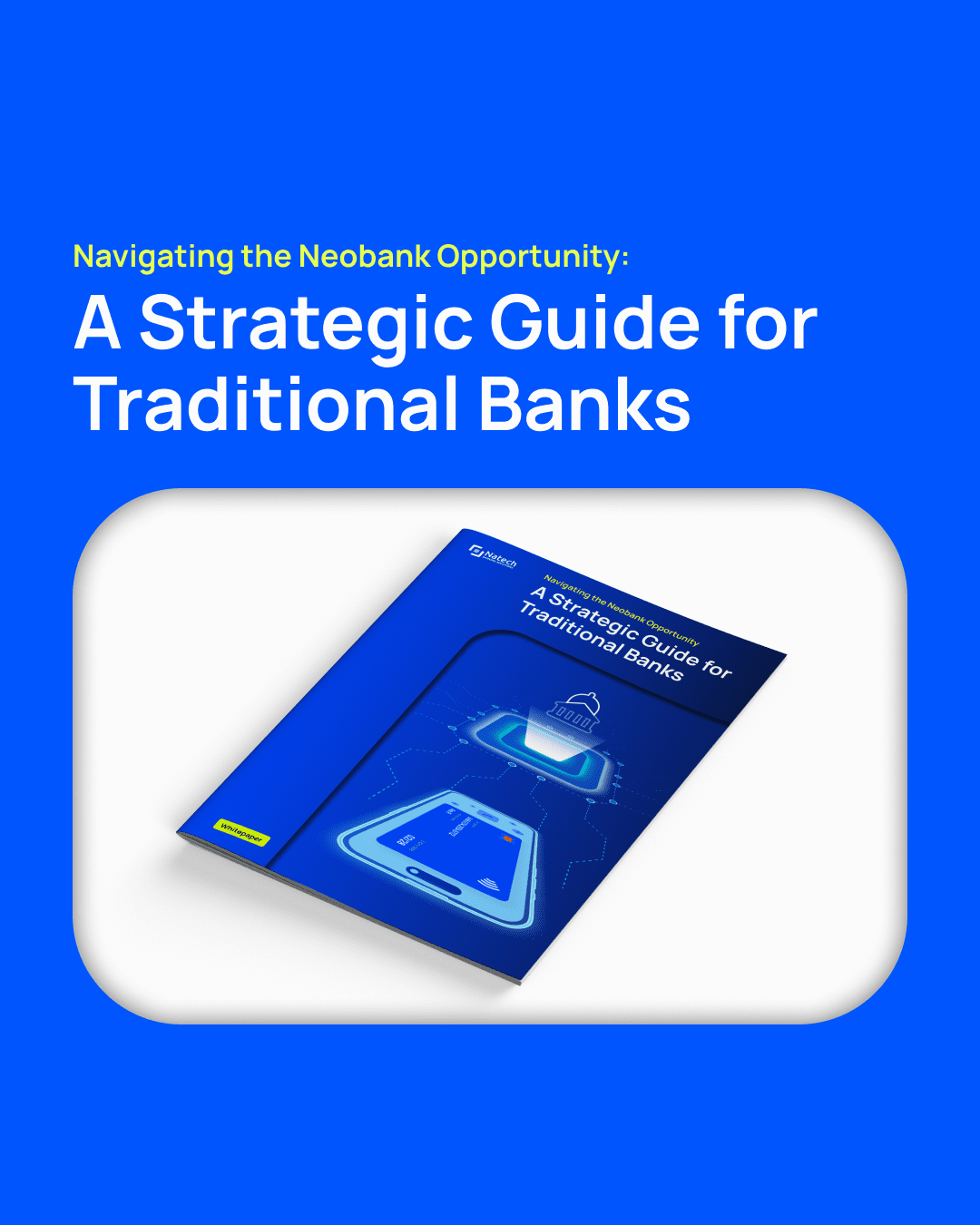Navigating the Neobank Opportunity – Strategies for Traditional Banks

Neobanks are transforming the banking industry, setting new standards for digital onboarding, AI-driven financial management, and hyper-personalisation. By prioritising convenience, automation, and seamless user experiences, they are reshaping customer expectations and driving the demand for fully digital banking solutions.
With the neobanking market projected to reach $3.3 trillion by 2032, expanding at an annual growth rate of 47%, this shift is not just a passing trend—it signals a broader transformation in how financial services are designed, delivered, and consumed.
What are the key factors behind this rapid expansion? And more importantly, how can traditional banks adapt to remain competitive in this evolving financial landscape?
The Rise of Neobanks: What’s Driving Their Growth?
The rise of neobanks is not just about digital convenience—it is driven by shifting consumer expectations, advancements in financial technology, and an increasingly competitive landscape. As demand grows for seamless financial services, real-time insights, and hyper-personalised experiences, neobanks are redefining modern banking.
At the same time, developments in cloud computing, AI, and embedded finance have made it easier than ever to build agile, customer-centric solutions. For traditional banks, the pace of change is outstripping the adaptability of legacy systems. Understanding the factors behind neobanks’ success is essential for incumbents seeking to stay relevant, retain customers, and compete effectively in a digital-first world.
Digital-First, Customer-Centric Experiences
Customer expectations have changed. Traditional banking, with its reliance on physical branches, paperwork, and manual processes, creates friction—barriers that digital-native banks have removed. Neobanks offer frictionless, digital-first experiences, allowing users to open accounts in minutes rather than days.
A recent study found that 67% of consumers now prefer digital-only banking services, and this number continues to rise. AI-powered financial tools, automated budgeting, and real-time analytics improve customer engagement, making hyper-personalisation the new standard.
Cloud-Native, API-Driven Scalability
While many traditional banks operate on legacy infrastructure, neobanks are designed with cloud-native architectures, enabling greater agility, scalability, and seamless integrations.
Cloud-based platforms enable faster innovation, allowing new financial products to be introduced in months rather than years. Open APIs facilitate fintech partnerships, making Banking-as-a-Service (BaaS) and embedded finance models more accessible. This improves cost efficiency and enables banks to scale effectively.
Embedded Finance & BaaS: Banking Beyond Banks
Neobanks are not just financial institutions; they are platforms enabling financial services to be embedded into non-banking ecosystems, from e-commerce and gig economy platforms to retail and corporate finance.
Embedded finance is projected to reach $570.9 billion globally by 2033, allowing brands to integrate banking, lending, and payments into their offerings. This model lets businesses offer financial services without needing a banking licence, creating new revenue streams and improving financial access.
Lifestyle Banking, ESG, & Hyper-Personalisation
Today’s customers expect more than just banking—they want financial services that reflect their values and lifestyles.
Many neobanks offer ESG-friendly investment portfolios, carbon footprint tracking, and ethical banking options, appealing to socially conscious consumers. Hyper-personalisation, powered by AI, provides tailored financial recommendations, automated savings, and personalised spending insights. With 70% of Gen Z and Millennials preferring financial institutions that align with their values, lifestyle-driven banking is becoming a key differentiator.
Challenges for Traditional Banks in a Digital-First World
Despite their established customer bases, regulatory expertise, and industry experience, traditional banks are finding it harder to compete with digital-first challengers. Outdated technology, slow innovation cycles, and rigid organisational structures make it difficult to match the speed, agility, and customer focus of neobanks.
Legacy Infrastructure Slows Innovation
Many banks continue to operate on decades-old core banking systems, making it difficult to introduce new digital services efficiently. More than 70% of financial institutions still rely on legacy infrastructure, creating bottlenecks that slow innovation and transformation.
While neobanks can roll out new features in months, traditional banks often take 12–24 months to introduce similar advancements. This slow pace makes it difficult to keep up with changing customer expectations and market demands.
The Customer Experience Gap
Neobanks have reshaped customer expectations, delivering seamless, intuitive, and fully digital experiences that many traditional banks struggle to match.
A study found that 63% of businesses believe legacy banks are too slow in meeting their financial needs. Meanwhile, neobanks can onboard new customers up to four times faster, using automation, instant verification, and a simplified digital onboarding process. Without substantial improvements in digital engagement, traditional banks risk losing both individual and business customers to more agile competitors.
Revenue Challenges & Shrinking Margins
Banks that fail to adapt their business models risk losing market share not only to neobanks but also to fintechs, technology-driven financial platforms, and non-traditional competitors, including telecom and retail-based financial services.
Neobanks, in contrast, have successfully diversified their revenue models, moving beyond traditional banking services. Through subscription-based offerings, embedded finance, and Banking-as-a-Service (BaaS) partnerships, they have created new and scalable revenue streams. Banks that fail to adapt their business models risk losing market share not only to neobanks but also to fintechs, big tech companies, and alternative financial service providers.
Strategic Approaches to Digital Transformation
To remain competitive, traditional banks must embrace digital transformation while balancing innovation with operational stability. There are three main approaches:
Incremental Modernisation
Some banks opt to upgrade their legacy systems gradually, integrating new technologies step by step. This approach minimises disruption and spreads out costs, making it a low-risk strategy. However, without a clear long-term vision, incremental changes often lack the speed and agility needed to compete effectively with digital challengers.
Full System Overhaul
A complete replacement of outdated systems allows banks to build modern, digital-first capabilities from the ground up. This approach removes legacy constraints, unlocking greater efficiency and innovation. However, it is a complex, costly, and disruptive process that can take years to implement, with significant operational risks.
Greenfield Digital Banking
A growing number of banks are choosing to launch standalone, digital-first banking entities, free from legacy constraints. This greenfield approach allows them to adopt modern technologies and business models while keeping their existing operations intact.
This approach enables banks to accelerate the launch of digital-first entities, often within months, while bypassing many bureaucratic and technological constraints typically associated with legacy systems. Cloud-based platforms lower costs and remove inefficiencies, improving operational efficiency. AI-driven insights support hyper-personalisation, helping banks provide real-time financial advice, automated savings, and tailored customer experiences.
A greenfield model also allows for flexibility, enabling banks to test, refine, and scale digital innovations at a much faster pace without disrupting their core banking operations.
Key Takeaways: Navigating the Future of Banking
Neobanks have reshaped banking expectations, offering seamless digital experiences, hyper-personalisation, and real-time financial services. As customer demands continue to evolve, traditional banks must modernise, adapt, and strategically transform to remain competitive in a digital-first world.
📥 For an in-depth look at the strategies banks can adopt, download our latest whitepaper, Navigating the Neobank Opportunity: A Strategic Guide for Traditional Banks











